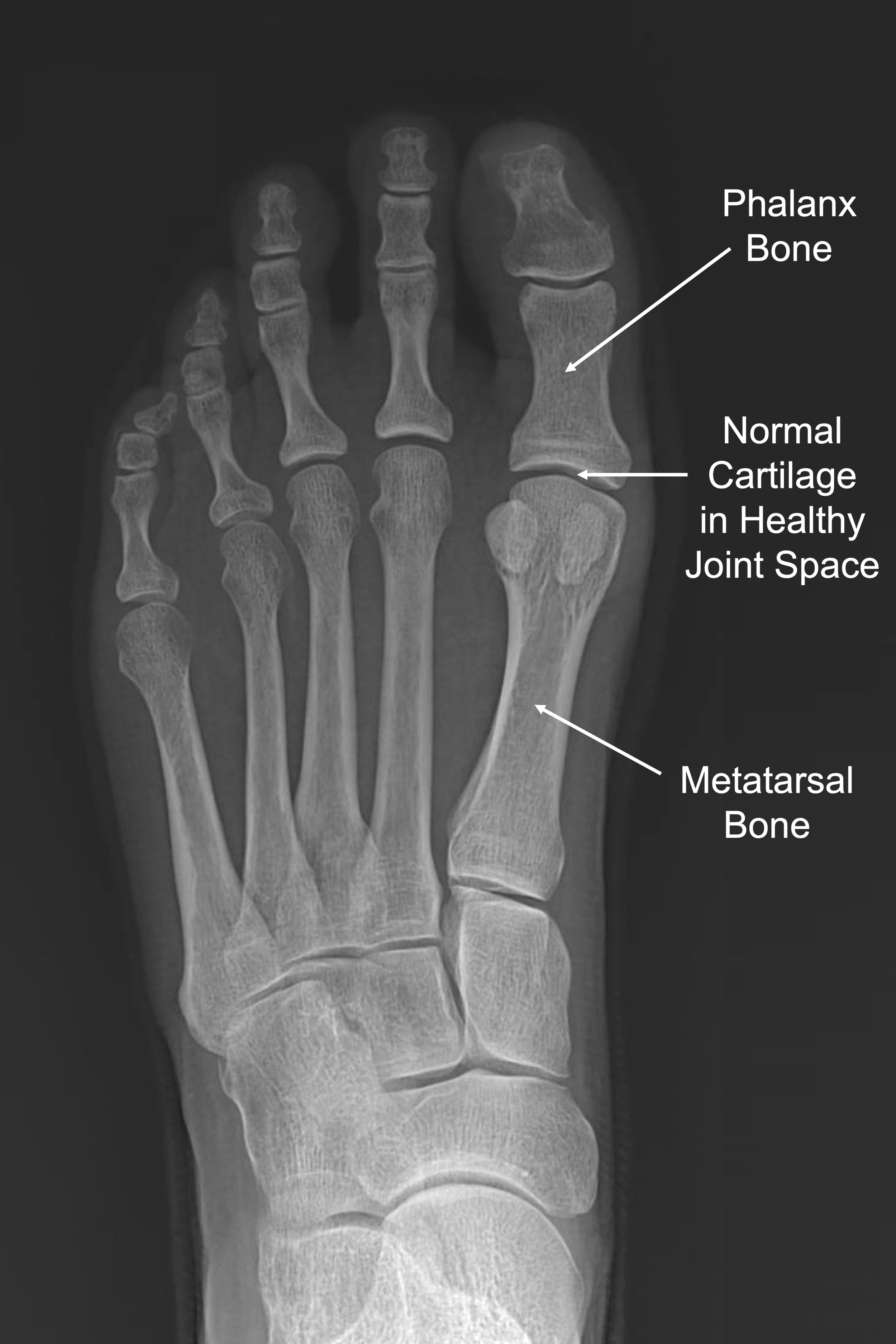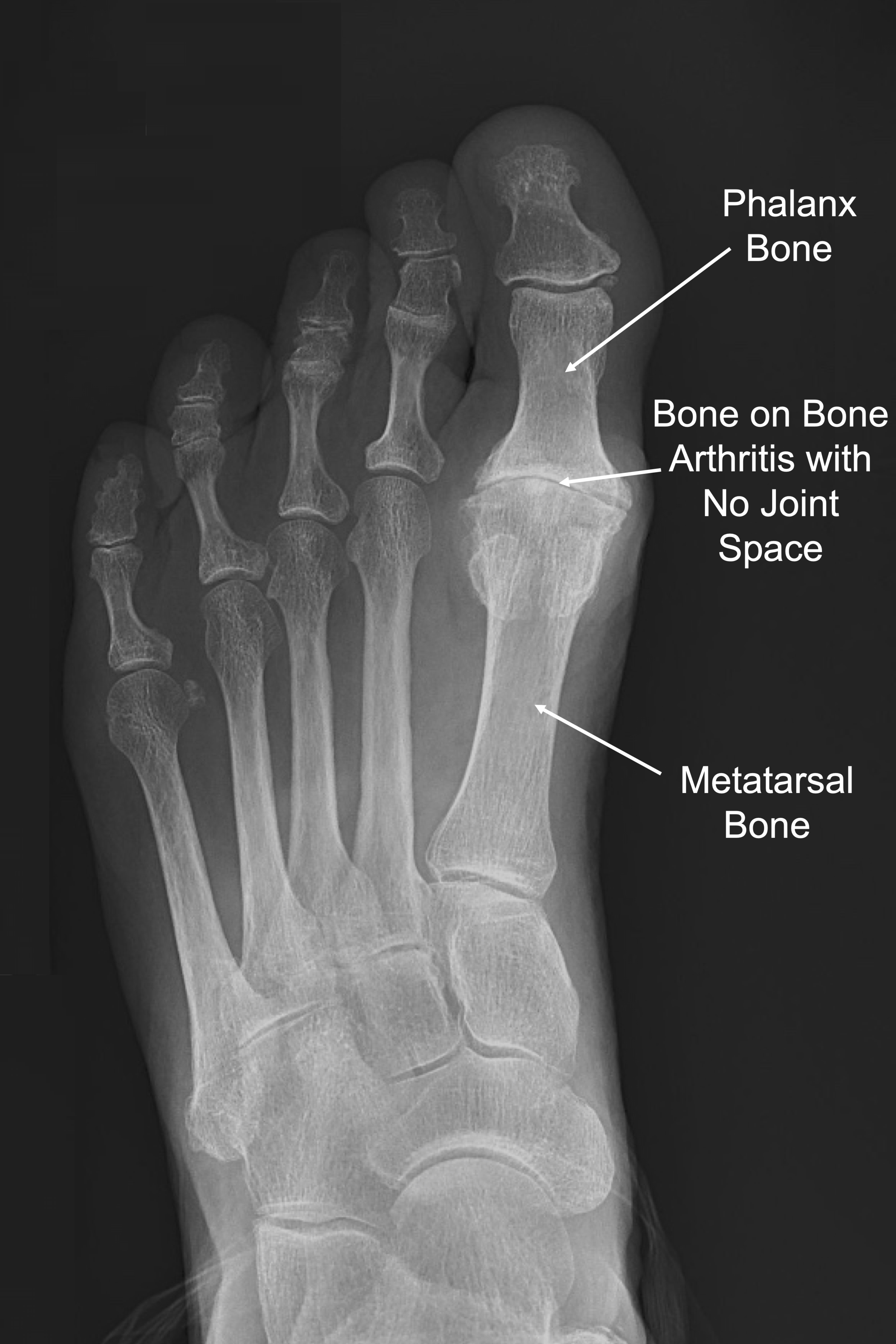Big Toe Arthritis
The phalanx bone and the metatarsal bone create a joint at the base of the big toe called the metatarsophalangeal joint. Wear and tear and aging can result in the loss of cartilage from this joint. When this occurs, you develop big toe arthritis, also known as hallux rigidus or hallux limitus.
When the cartilage is gone, you have “bone on bone” contact, which leads to pain and stiffness within the joint. Because we put weight on our big toe at the end of every step, the big toe joint experiences the greatest loads at this point during gait. That’s why big toe arthritis hurts most at the end of each step, as you push off with the toe and transfer your weight to the other foot.
Big toe arthritis can create significant disability. It can cause a debilitating pain with activities as simple as walking or running. The disease can inhibit you from being your best self in your personal, family, and professional lives.
Fortunately, there are excellent surgical and nonsurgical treatments to help with your pain. Surgery for big toe arthritis is one of the most effective and most routinely performed procedures in all of foot and ankle surgery.
Nonsurgical treatment
Examples of carbon fiber foot plates
Nonsurgical treatment of big toe arthritis consists of the following:
Carbon fiber insole or stiff soled shoe
Anti-inflammatory medications (oral or topical)
Injections of steroid directly into the joint
During the push-off phase of gait, right before your foot leaves the ground, your big toe is forced into extension. This causes bone on bone contact within the joint, which triggers pain and inflammation.
A carbon fiber insole works by protecting your big toe at this point during the gait cycle. The insole takes the stress off the big toe, reliving some or all of your pain. Make sure to put the carbon fiber insole below the origional insole that came with the shoe so that the carbon fiber insole is well padded.
A carbon fiber insole is a great way to stiffen a shoe you already have. Using a shoe with a naturally stiff sole (like a hiking boot or solid walking shoe) can work well too.
If you think you know your diagnosis, you can feel free to get started on some of these treatments before you even come in. When you do come in, please bring any orthotics so that Dr. Bohl can take a look.
Surgical option #1: Cheilectomy
In patients with mild or moderate big toe arthritis, some cartilage still remains, but spurs of bone (osteophytes) form on the top of the joint. These spurs bump together during the push-off phase of gait, when your big toe is forced into extension, right before your foot leaves the ground. The bone on bone contact between the spurs blocks motion and causes pain, inflammation, and stiffness.
From a surgical perspective, a reliable solution is to remove the spurs. This procedure is called a minimally invasive cheilectomy, and works by eliminating the painful bony block to extension, facilitating return to activity and relief of pain.
The cheilectomy a fast and low-risk procedure, performed through a small incision on the top of the foot. You are allowed to walk immediately following surgery. We typically recommend a few sessions of physical therapy or a home exercise program postoperatively to make sure you get as much motion as possible as a result of the procedure.
Surgical option #2: Big toe fusion
Big toe fusion with plate and screws
For patients with severe big toe arthritis, Dr. Bohl recommends fusion of the arthritic joint. This is an incredibly functional procedure and has very high rates of return to activity and patient satisfaction.
In patients with severe arthritis, the big toe joint doesn’t move much anyway. We often say that a fusion takes a “stiff and painful” joint and makes it into a “stiff and painless” joint. That is to say — you will not miss the motion at all. Additionally, you should understand that we are only fusing one of the two joints in the big toe (the metatarsophalangeal joint). The joint that you can feel doing most of the motion (the interphalangeal joint) is left alone and remains mobile.
In a big toe fusion, a small incision is made over the top of the toe. Bone spurs and inflamed tissue are removed. The joint surfaces prepared for fusion. Metal screws and a plate are used to hold the bones while the fusion heals. Postoperatively, you are allowed to bear weight immediately. However, we still recommend you get a knee scooter to make life easier over the first few weeks.
The most important part of a big toe fusion is the surgeon placing the two bones in the right place. If the toe is fused too far down, the toe will take up too much of the body’s weight. If the toe is fused too far up, the toe will not take up enough of the body’s weight. Dr. Bohl focuses great attention on getting this alignment just right.
Once healed, the metal is obsolete. In most patients, the metal doesn’t cause any problem and can be left in place without the patient ever thinking about it again. A minority of patients choose to have it removed, which is a very minor procedure.
Revision big toe surgery
Dr. Bohl commonly sees patient referrals who have had surgery and are unhappy with their result. He specializes in and enjoys correcting these prior procedures. He will be happy to evaluate your foot and help you to consider your options for a revision.
If you had surgery elsewhere, please do your best to gather your old records. The most important document for patients with prior big toe surgery is the “operative report.” If you can get this from your previous surgeon, it is helpful. Please hand carry your operative report to your visit rather than trying to have it sent to us.



